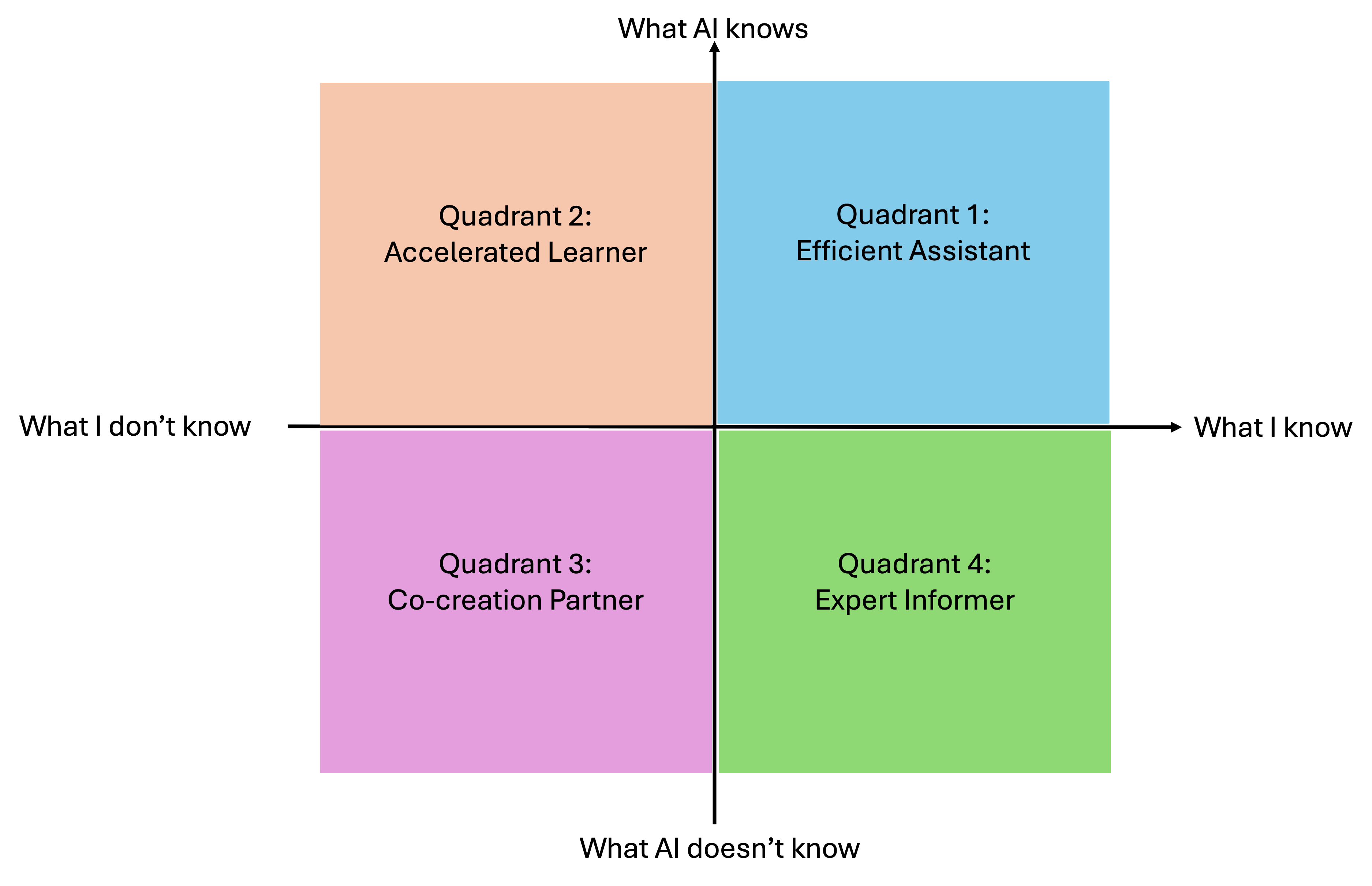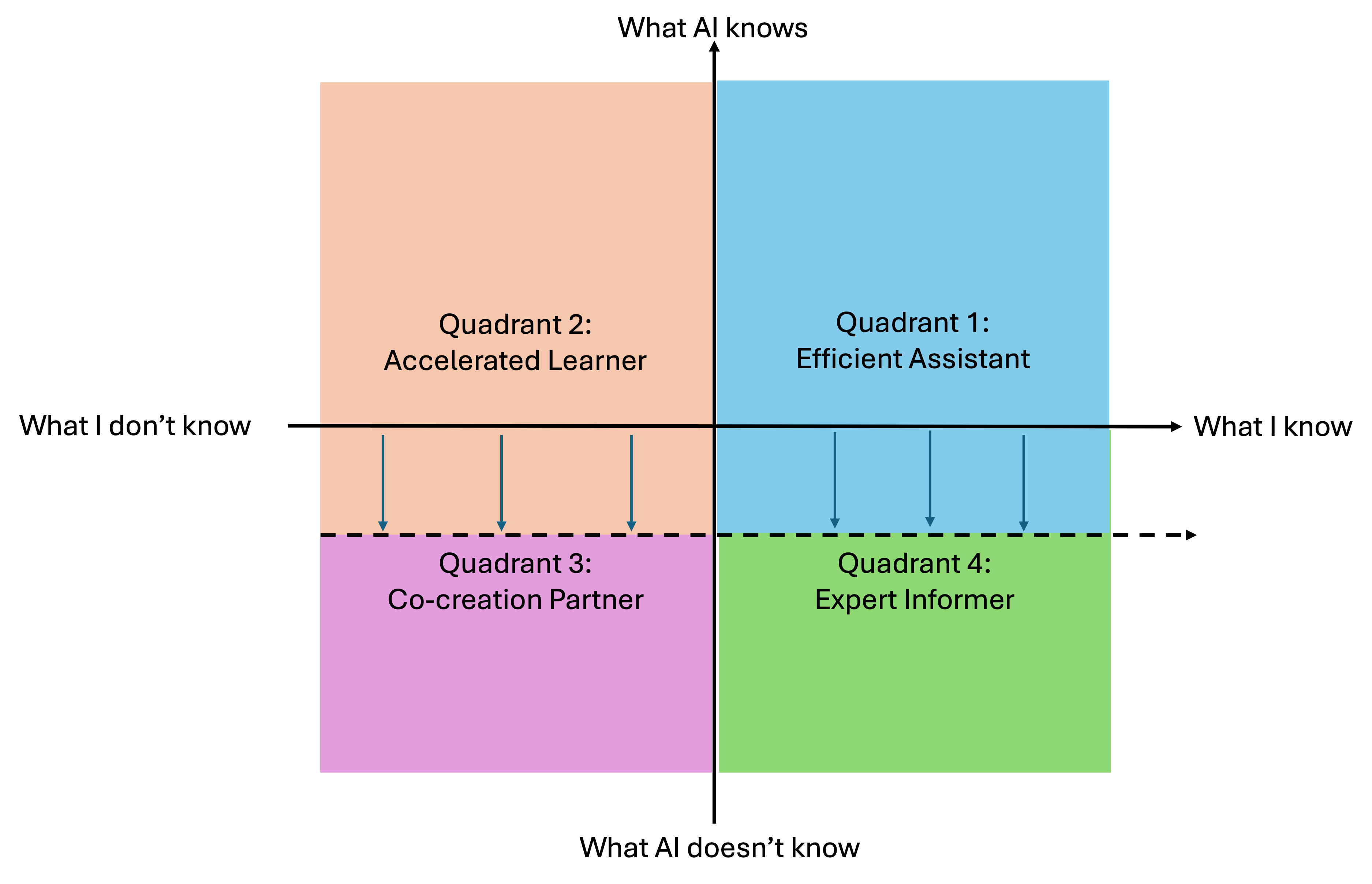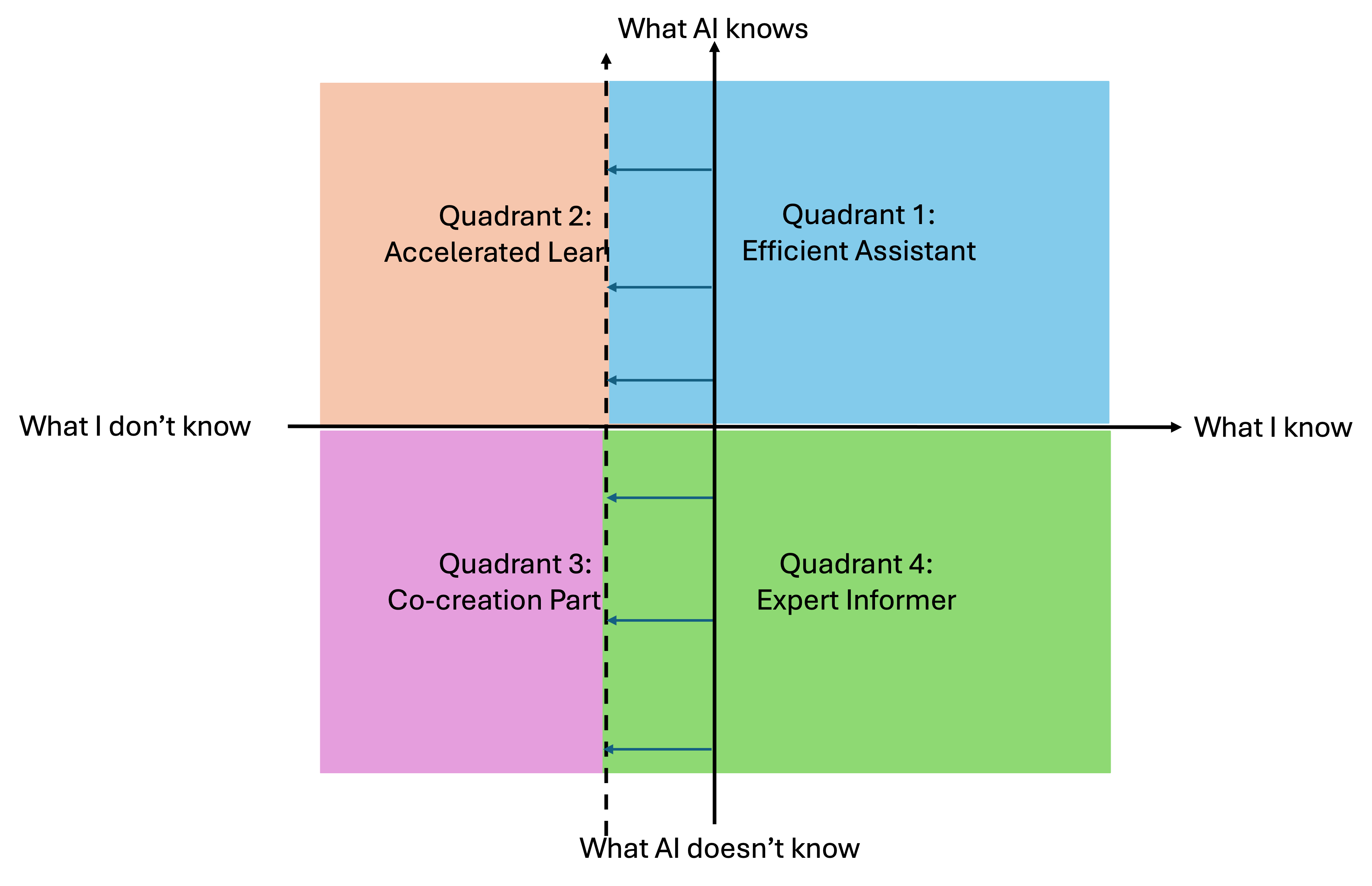As tools like ChatGPT reshape how we work, prompting—the skill of designing effective instructions to guide AI behavior—has become a new critical skill. Techniques like zero-shot, few-shot, and chain-of-thought can improve outputs at a tactical level. But they cannot answer the bigger questions: which approach should you choose for which situation? and how can we collaborate with AI effectively?
To address these challenges, I’d like to introduce the Four-Quadrant Framework of AI Dialogue, a practical model inspired by the psychological Johari Window Model—a framework originally developed by psychologists Joseph Luft and Harrington Ingham in 1955 to improve self-awareness and interpersonal communication. This adaptation helps us better understand how knowledge is shared between humans and AI, and how to design interactions that are more intentional and impactful.
By mapping what the human and AI each know or don’t know-or don’t know- we gain clearer insight into when to teach, learn, co-create, or delegate. In doing so, we begin to see not just how to better design prompts, and more importantly how to build better partnerships with AI.
Understanding the Four Quadrants

This framework divides interaction types into four quadrants, each reflecting a different configuration of knowledge between the user and the AI. Recognizing these distinctions helps you choose the right prompting strategy and unlock more effective, goal-oriented collaboration:
Quadrant 1: Efficient Assistant (AI Knows, I Know)
This is the most straightforward type of collaboration. Both you and the AI have the knowledge and understand the task, and the focus is on execution.
Example: You ask AI to polish a draft you’ve written. Since the context is clear to both, the AI can efficiently enhances the content with improved grammar, clarity, and tone.
What You Should Do: Write clear, specific, and detailed instructions. Provide context, objectives, tone preferences, and any formatting or constraints. The more structured your input, the better the AI can mirror your intent.
AI’s Role: Executes tasks with shared understanding as an efficient assistant.
Quadrant 2: Accelerated Learner (AI Knows, I Don’t Know)
Here, the AI holds information you lack. The key is asking the right questions to unlock that knowledge.
Example: Exploring Model Context Protocol (MCP) through layered questions like:
- What is MCP?
- What problem does MCP aim to solve?
- What are the core concepts and architecture behind MCP?
- How does MCP compare to other protocol approaches in AI systems?
- In what real-world scenarios could MCP provide strategic advantages
- What are its limitations?
What You Should Do: Ask systematic, structured, and layered questions to uncover deeper insights. Start with broad definitions, then drill into details, comparisons, use cases, and edge scenarios. Refine your prompts as your understanding improves.
Human Role: Drives learning process through iterative inquiry.
Quadrant 3: Co-Creation Partner (AI Doesn’t Know, I Don’t Know)
This is a collaborative space where neither party holds all the answers. you and the AI are exploring together, without predefined answers. It’s ideal for brainstorming, discovery and exploration.
Example: Brainstorming new business models or solving problems with limited precedent. AI offers raw ideas, while you provide judgement, evaluate and direct the process.
What You Should Do: Prompt the AI with open-ended questions, outline constraints, and explore multiple directions. Evaluate AI-generated ideas critically, combine them with your intuition, and refine outputs through back-and-forth collaboration.
Human-AI Role: Partnered ideation—AI generates, you evaluate and synthesize.
Quadrant 4: Expert Informer (AI Doesn’t Know, I Know)
This quadrant is about transfer. You provide proprietary or specialized knowledge that the AI lacks. The goal is not to retrieve answers but to train and inform.
Example: Supplying internal business documents for summarization or analysis. Techniques like RAG (Retrieval-Augmented Generation) or SFT (Supervised Fine-Tuning) help embed the context AI lacks.
What You Should Do: Clearly structure and articulate the knowledge you want the AI to leverage. Give background, define terms, and explain relevance. Use prompts like “Summarize with a focus on X” or “What patterns emerge from these reports?”. Continuously refine the AI’s understanding through iterative feedback.
Human Role: Knowledge integrator—transfers domain-specific insights to AI. Serve as a subject-matter guide—teaching the model what it needs to know.
Quadrants 2 and 4 are particularly valuable: in one, AI teaches you; in the other, you teach AI. Both require clear context, intentional, and high-quality prompts for optimal collaboration.
Adapting in an Evolving AI Landscape
 The quadrants aren’t fixed. They evolve as AI’s capabilities grow. The knowledge boundaries of AI are constantly expanding. AI is continually pushing its horizontal knowledge axis downwards, meaning Quadrant 1 (AI knows, I know) will continuously expand, and Quadrant 4 (AI doesn’t know, I know) will continuously shrink as AI absorb more public knowledge and emerging techniques like RAG extend their reach.
The quadrants aren’t fixed. They evolve as AI’s capabilities grow. The knowledge boundaries of AI are constantly expanding. AI is continually pushing its horizontal knowledge axis downwards, meaning Quadrant 1 (AI knows, I know) will continuously expand, and Quadrant 4 (AI doesn’t know, I know) will continuously shrink as AI absorb more public knowledge and emerging techniques like RAG extend their reach.
So, what remains our human advantage? Our tacit domain expertise, intuitive reasoning, and context-specific insights continue to be areas where AI exhibits limited understanding or adaptability. Unlike AI, humans bring lived experiences, cultural context, emotional intelligence, and ethical judgement - qualities that don’t fit neatly into datasets.

As humans, we must also evolve-actively shift our knowledge boundary (vertical axis) to the left-learn more and learn faster, perhaps with the assistance of AI. The deeper and more extensively you query AI in Quadrant 2 and collaborate in Quadrant 3, the more exponential growth and greater returns you will achieve.
To maximize this opportunity:
- Treat Quadrant 2 as your active learning lab. Ask systematic, layered questions, test your understanding, and use AI to uncover nuances and edge cases.
- Use Quadrant 3 as your innovation studio. Explore new ideas, experiment with perspectives, and refine outputs through iteration.
Together, these actions would improve your ability to both learn from and build with AI.
Core Skills for Effective AI Collaboration
To operate across all four quadrants, focus on these four core skills:
- Strategic Questioning: Break down complex subjects and guide the AI through structured inquiry.
- Knowledge Articulation: Express what you know in clear, structured , and organized formats that AI can process.
- Collaborative Exploration: Work with AI as a partner, especially in ambiguous or novel tasks.
- Adaptive Strategy: Stay informed about AI capabilities and adjust your adjust your approach as AI evolves.
Final Thoughts
In an age where knowledge is abundant, the advantage belongs to those who know how to ask better questions, apply sharper judgment, and create context where it matters most.
Einstein once said, “Imagination is more important than knowledge.” Today, we might add: your ability to guide AI’s imagination is just as essential.
Don’t just use AI. Work with it. Learn from it. Teach it. Build with it.
Which quadrant are you working in today? What would help you co-create more effectively with AI? Let’s explore that together.